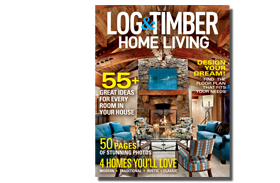
Nearly every log-home floor plan you see nowadays labels an open central space as “great room.” Great rooms have become so much a signature feature of log-home layouts that many people take the space for granted without necessarily understanding how to handle it. There’s more planning involved than just filling it with furniture. Great rooms are, after all, your home’s most public room.
They combine the living, dining and kitchen areas that most conventional homes wall off from each other. By flowing these three spaces together, well-designed great rooms signal the informality that makes log homes so appealing. Also, the free-flowing layout spreads natural light and views to all corners.
Great rooms aren’t exclusive to log homes and began showing up in log-home plans in the 1980s, inspired by the openness of the grand lodges of the West. Eliminating walls and halls does create vastness, however, and can unsettle homeowners accustomed to formal room divisions when they start designing their log-home great room. Where does the living space stop and the eating space start? How do you keep company close to the kitchen but outside it? Defining boundaries without walls can prove challenging.
Cues can designate niches. The well-designed great room typically has five major focal points: the window wall, the fireplace, the loft, the ceiling and the stairs and railings. Nooks and groupings within the space can supplement these main points and enliven your great-room design. There are many variations and finer points to consider.
Furniture is separate from design. Suffice it to say that the scale of great rooms can dwarf furniture meant for smaller, walled rooms. Size your great room to accommodate larger pieces. Avoid clutter, though; save some openness.
See more 6 Stylish Lights for the Log Home




